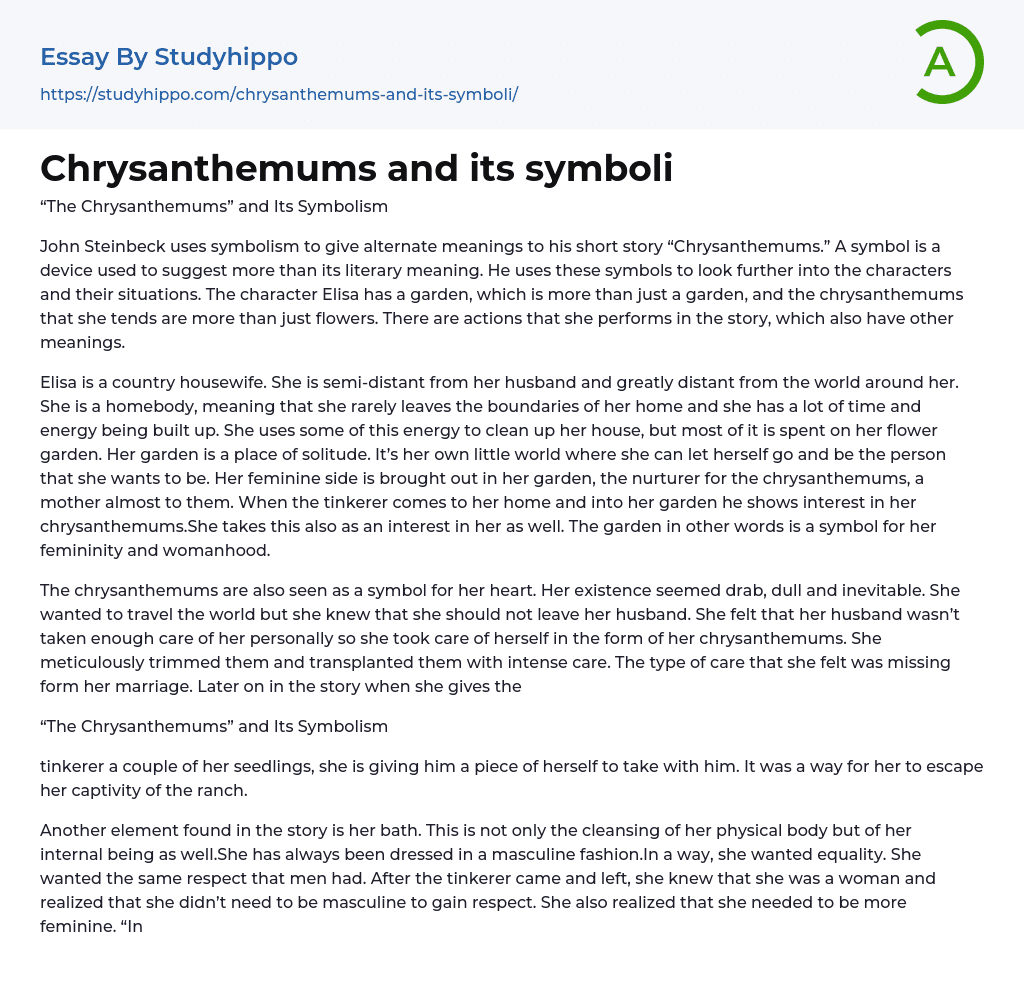In his story "The Chrysanthemums," John Steinbeck utilizes symbolism to convey deeper meanings. Each symbol employed sheds light on the characters and their circumstances, particularly Elisa, the protagonist. Elisa's garden goes beyond being a typical one; it holds significant meaning. The chrysanthemums she nurtures are more than mere flowers. Moreover, her actions in the story possess additional significance.
Elisa is depicted as a rural housewife who feels somewhat disconnected from her husband and largely detached from the world. Choosing to stay within the confines of her home amplifies her role as a homebody, granting her ample time and energy reserves. While she expends some of this energy maintaining her house, most of it is directed towards tending her flower garden. This garden serves as both a sanctuary and a personal realm where she can freely express herself and embody he
...r aspirations.
Through her garden, Elisa's feminine qualities are accentuated; she becomes a nurturing mother figure to her chrysanthemums. When a traveling repairman enters her domain and shows interest in her flowers, Elisa interprets it as an interest in herself. Hence, the garden becomes symbolic of both Elisa's femininity and womanhood. Additionally, the chrysanthemums themselves symbolize Elisa's heart.
Elisa's life seems monotonous, lackluster, and trapped in inevitability. Although she yearns to explore the world outside of marriage, leaving her husband is not an option that she accepts.She believes her husband neglects her, so she cares for her chrysanthemums as a way to care for herself. She meticulously trims and moves them, filling the void in her marriage. When she gives some of the seedlings to the tinkerer, it symbolizes giving him a part of herself to escape the ranch.
Elisa's bath is also significant; it cleanses her physical body and purifies her inner self. Elisa has always dressed like a man to seek equality and respect. However, after the tinkerer's visit, she realizes her true femininity and understands that embracing masculinity is unnecessary for respect. Through this ritualistic act, Elisa gains feminine strength. Towards the end of the story, Elisa finds her discarded seedlings by the roadside. The tinkerer's lack of interest beyond money is revealed through his actions, which bring fortune to Elisa too.The presence of symbolism in the short story, "The Chrysanthemums," adds intrigue and excitement to the narrative. The chrysanthemums themselves symbolize the protagonist's eternal commitment to a passionate marriage, comparing it to growing "like an old woman." This richly symbolic story allows readers to uncover deeper meaning and significance within the author's writing.
- Book Summary essays
- Metaphor essays
- Reader essays
- Rhyme essays
- Literary devices essays
- Villain essays
- Books essays
- Genre essays
- Literary Criticism essays
- Writer essays
- Protagonist essays
- Simile essays
- Poem essays
- Book Report essays
- Book Review essays
- Greek Mythology essays
- Plot essays
- Tragic Hero essays
- Coming of Age essays
- Play essays
- Rhetoric essays
- Rhetorical Question essays
- Translation essays
- Understanding essays
- Reason essays
- Character essays
- Letter essays
- American Literature essays
- Literature Review essays
- Utopia essays
- Poetry Analysis essays
- Dante's Inferno essays
- Between The World and Me essays
- Incidents in The Life of a Slave Girl essays
- Flowers for Algernon essays
- Myth essays
- Everyday Use essays
- Boo Radley essays
- Genesis essays
- Richard iii essays
- Alice in Wonderland essays
- On the road essays
- Ozymandias essays
- The Nightingale essays
- Holden Caulfield essays
- Animal Farm essays
- 1984 essays
- A Hanging essays
- Shooting An Elephant essays
- A Tale Of Two Cities essays




